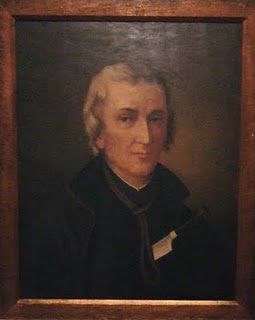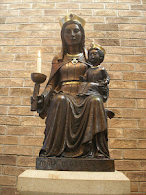Today we celebrate the feast of Our Lady of the Rosary. On this day in 1571, the great naval Battle of Lepanto was fought between an alliance of Christian Countries and the Ottoman Empire. Our Lady’s intercession had been invoked and a Rosary Procession had taken place that day in Rome. In thanksgiving to the Virgin Mary, Pope Pius V instituted the Feast of Our Lady of Victory. In acknowledgement that the victory was the fruit of the Rosary, Pope Gregory XIII, in 1573, changed the name to the Feast of the Holy Rosary. The Feast was kept on the first Sunday of October but, in 1913, Pope Pius X changed the date of the celebration to 7th October. Another change came in 1969 when Pope Paul VI changed the name to Our Lady of the Rosary.
Although there have been changes to the name and date of the Feast of the Holy Rosary, one thing has remained constant. That is the sincere devotion to Mary and the Holy Rosary. Through the centuries, Catholics have turned to Mary in times of joy and times of sorrow. In the Mysteries of the Rosary, and accompanied by Mary, they have walked with Jesus from Bethlehem to Calvary and beyond.

Even during the life of King Henry VIII, those who clung to the Old Faith also clung to Mary. Ten years after the bloody martyrdoms began, Henry’s famous flagship, ‘Mary Rose’, went down off the Isle of Wight in 1545. In the early 1980s ‘Mary Rose’ was raised and many well preserved items were recovered. Among the recovered items was a wooden Rosary! Some long ago Tudor sailor’s love of Mary and the Rosary was stronger than all the King’s wrath.
In Penal times, both in England and its overseas colonies, the Rosary helped keep the faith alive. With no priest available to celebrate Mass and the Sacraments, Catholics would gather in secret to recite the Rosary. In Penal Days in Ireland, the Penal Rosary, a string of ten beads designed to be used discretely up a sleeve or in a pocket, was widely used. Not many original Penal Rosaries survive, but modern versions are readily available.
The martyrs too were devoted to Mary and the Rosary. St Henry Walpole, St Luke Kirby, and St Thomas Garnet, to name but a few, mounted the gallows steps with the ‘Hail Mary’ on their lips. Some sources say that St John Boste was saying the Angelus as he mounted the gallows while other sources state that he was praying the Rosary. Angelus or Rosary, John Boste sought the assistance of the Mother of God!
Shortly before his execution, twenty-five year old St Alexander Briant wrote to the English Jesuits; “The same day that I was first tormented on the rack, before I came to the place, giving my mind to prayer, and commending myself and all mine to Our Lord, I was replenished and filled up with a kind of supernatural sweetness of spirit; and even while I was calling upon the name of Jesus and upon the Blessed Virgin Mary (for I was saying the Rosary), my mind was cheerfully disposed, well comforted, and readily prepared and bent to suffer and endure those torments which even then I most certainly looked for."
St John Ogilvie was martyred at Glasgow Cross on 10th March 1615. He had secreted on his person his treasured Rosary beads and, after he was pushed off the gallows steps, he triumphantly flung his beads into the crowd. It was said that the beads were caught by one of his enemies who eventually became a Catholic.
The Blessed Virgin Mary herself has asked us to pray the Rosary daily. On this beautiful Feast of Our Lady of the Rosary, let us be diligent in responding to her plea.
Although there have been changes to the name and date of the Feast of the Holy Rosary, one thing has remained constant. That is the sincere devotion to Mary and the Holy Rosary. Through the centuries, Catholics have turned to Mary in times of joy and times of sorrow. In the Mysteries of the Rosary, and accompanied by Mary, they have walked with Jesus from Bethlehem to Calvary and beyond.

Even during the life of King Henry VIII, those who clung to the Old Faith also clung to Mary. Ten years after the bloody martyrdoms began, Henry’s famous flagship, ‘Mary Rose’, went down off the Isle of Wight in 1545. In the early 1980s ‘Mary Rose’ was raised and many well preserved items were recovered. Among the recovered items was a wooden Rosary! Some long ago Tudor sailor’s love of Mary and the Rosary was stronger than all the King’s wrath.
In Penal times, both in England and its overseas colonies, the Rosary helped keep the faith alive. With no priest available to celebrate Mass and the Sacraments, Catholics would gather in secret to recite the Rosary. In Penal Days in Ireland, the Penal Rosary, a string of ten beads designed to be used discretely up a sleeve or in a pocket, was widely used. Not many original Penal Rosaries survive, but modern versions are readily available.
The martyrs too were devoted to Mary and the Rosary. St Henry Walpole, St Luke Kirby, and St Thomas Garnet, to name but a few, mounted the gallows steps with the ‘Hail Mary’ on their lips. Some sources say that St John Boste was saying the Angelus as he mounted the gallows while other sources state that he was praying the Rosary. Angelus or Rosary, John Boste sought the assistance of the Mother of God!
Shortly before his execution, twenty-five year old St Alexander Briant wrote to the English Jesuits; “The same day that I was first tormented on the rack, before I came to the place, giving my mind to prayer, and commending myself and all mine to Our Lord, I was replenished and filled up with a kind of supernatural sweetness of spirit; and even while I was calling upon the name of Jesus and upon the Blessed Virgin Mary (for I was saying the Rosary), my mind was cheerfully disposed, well comforted, and readily prepared and bent to suffer and endure those torments which even then I most certainly looked for."
St John Ogilvie was martyred at Glasgow Cross on 10th March 1615. He had secreted on his person his treasured Rosary beads and, after he was pushed off the gallows steps, he triumphantly flung his beads into the crowd. It was said that the beads were caught by one of his enemies who eventually became a Catholic.
The Blessed Virgin Mary herself has asked us to pray the Rosary daily. On this beautiful Feast of Our Lady of the Rosary, let us be diligent in responding to her plea.








.JPG)

.JPG)






This is certainly the best researched Blog I have seen and read ... often.
ReplyDeleteThank you for your time and patience.
God bless.
Good Morning Victor
ReplyDeleteThank you Victor. You are so very kind.
I really do want to spread the word about St David Lewis, so I try to find out as much as I can about his life and the times in which he lived. I suppose, after more than 300 years, there is only so much information available about him but I keep digging. I may be wrong, but I think every scrap of information about St David Lewis is worth posting because it is making him better known. I hope so anyway.
Again, I thank you Victor. You are always encouraging and I appreciate that, and your encouragement, very much. God bless you.